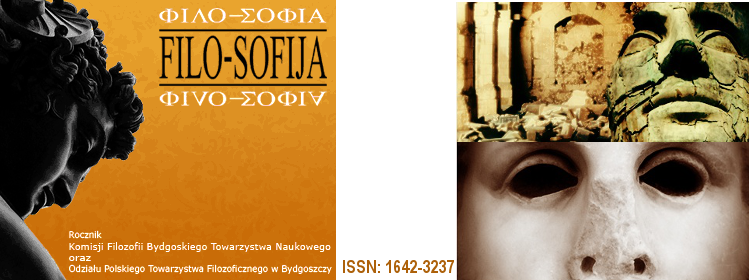Symbol i alegoria w filozoficznej egzegezie stoików
Abstract
Author: Domaradzki Mikołaj
Title: SYMBOL AND ALLEGORY IN THE PHILOSOPHICAL EXEGESIS OF THE STOICS (Symbol i alegoria w filozoficznej egzegezie stoików)
Source: Filo-Sofija
year: 2011, vol:.13/14, number: 2011/2-3, pages: 719-736
Keywords: STOIC EXEGESIS, SYMBOL, ALLEGORY, CHRYSIPPUS, CORNUTUS, HERACLITUS THE ALLEGORIST
Discipline: PHILOSOPHY
Language: POLISH
Document type: ARTICLE
Publication order reference (Primary author’s office address):
E-mail:
www:
Abstract The present paper aims to ascertain whether, and if so, to what extent the modern distinction between the concepts of ‘symbol’ and ‘allegory’ can be applied to Stoic hermeneutical activity. The philosophy of the Stoics invites such a discussion, since the philosophers were the first thinkers in antiquity to actually have used the terms with reference to the process of retrieving the hidden meaning of various literary constructions. Thus, Chrysippus’ interpretation of the myth of Athena’s birth provides the point of departure for our considerations, since it is in the philosopher’s exegesis that we find the very first use of the word ‘symbol’ understood as a theoretical tool for interpreting texts. Subsequently, the article proceeds to discuss the interpretations of the same myth that were presented by Cornutus and Heraclitus who use the words ‘symbol’ and ‘allegory’ interchangeably. While the paper argues that in none of the cases analyzed do we find an understanding of the terms ‘symbol’ or ‘allegory’ that would entirely correspond to modern definitions of the terms, it also stresses that the impossibility of classifying Stoic interpretations as either solely ‘symbolical’ or solely ‘allegorical’ does not diminish the cultural import of Stoic hermeneutical activity.
Title: SYMBOL AND ALLEGORY IN THE PHILOSOPHICAL EXEGESIS OF THE STOICS (Symbol i alegoria w filozoficznej egzegezie stoików)
Source: Filo-Sofija
year: 2011, vol:.13/14, number: 2011/2-3, pages: 719-736
Keywords: STOIC EXEGESIS, SYMBOL, ALLEGORY, CHRYSIPPUS, CORNUTUS, HERACLITUS THE ALLEGORIST
Discipline: PHILOSOPHY
Language: POLISH
Document type: ARTICLE
Publication order reference (Primary author’s office address):
E-mail:
www:
Abstract The present paper aims to ascertain whether, and if so, to what extent the modern distinction between the concepts of ‘symbol’ and ‘allegory’ can be applied to Stoic hermeneutical activity. The philosophy of the Stoics invites such a discussion, since the philosophers were the first thinkers in antiquity to actually have used the terms with reference to the process of retrieving the hidden meaning of various literary constructions. Thus, Chrysippus’ interpretation of the myth of Athena’s birth provides the point of departure for our considerations, since it is in the philosopher’s exegesis that we find the very first use of the word ‘symbol’ understood as a theoretical tool for interpreting texts. Subsequently, the article proceeds to discuss the interpretations of the same myth that were presented by Cornutus and Heraclitus who use the words ‘symbol’ and ‘allegory’ interchangeably. While the paper argues that in none of the cases analyzed do we find an understanding of the terms ‘symbol’ or ‘allegory’ that would entirely correspond to modern definitions of the terms, it also stresses that the impossibility of classifying Stoic interpretations as either solely ‘symbolical’ or solely ‘allegorical’ does not diminish the cultural import of Stoic hermeneutical activity.
Pełny tekst:
PDFAdministracja Cytowania | Strony czasopism
